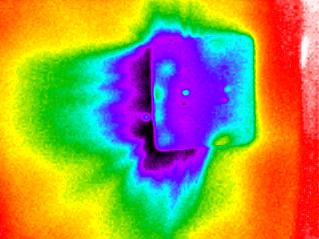
Infrared scan of light switch plate on the interior of an outside wall. The scan was made during a homeowner energy audit. Cold-to-hot on the color scale is: black, purple, dark blue, light blue, green, yellow, red. The scan, made during a blower test that caused air to infiltrate the house at a high rate, shows that there are significant air leaks around the plate.
Most homeowners would say that they’d love to save a few dollars on heating their houses. And caulk is cheap, right? So why would a homeowner who feels a draft hesitate to invest in a caulking gun and a tube of caulk? One possible reason: To do a really good, comprehensive job sealing up a whole house could require a $3,000 investment – in labor, caulk, spray foam, weatherstripping, and other materials.
So if homeowners are going to spend a few thousand dollars to improve the energy efficiency of their houses, maybe there’s a more cost-effective investment they could make – like throwing $2,000 worth of extra insulation in the attic.
The city of Ann Arbor has a similar challenge – if it receives more than $1 million in federal stimulus funding from the U.S. Department of Energy to invest locally. Andrew Brix, energy coordinator for the city, and other city staff need to answer the question: How do you spend that money in the most cost-effective way for the community?
Their tentative answer could include financial help for homeowners in the form of loans set up through a self-assessment energy financing district – help for homeowners like the one faced with the $2,000-for-air-sealing versus $3,000-for-attic insulation question.
The Chronicle didn’t pull those numbers out of a hat. We pulled them out of a Matt – as in Matt Naud’s energy audit report. Naud is the environmental coordinator for the city of Ann Arbor, and he agreed to let us shadow the Recycle Ann Arbor energy audit team as they conducted their analysis of his house. [Full Story]




